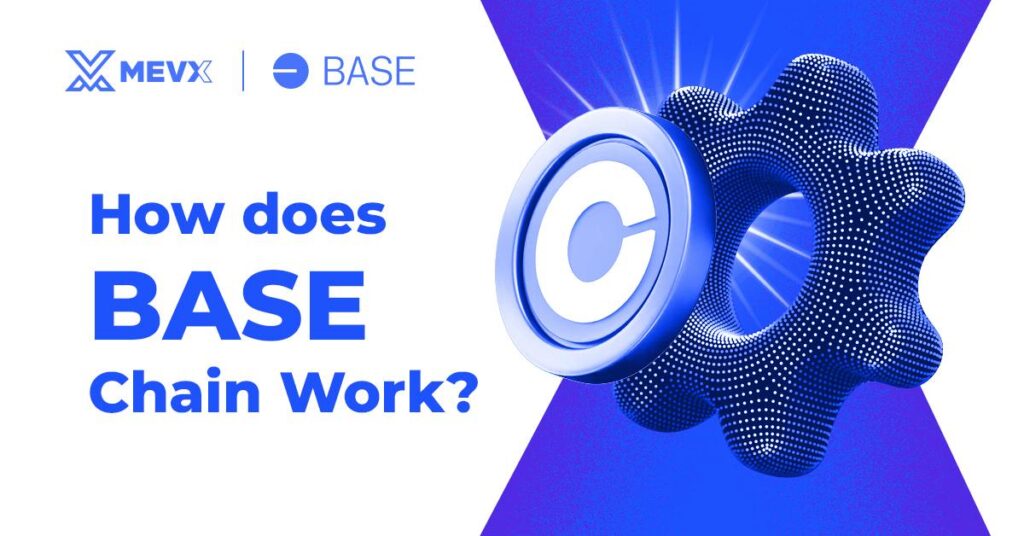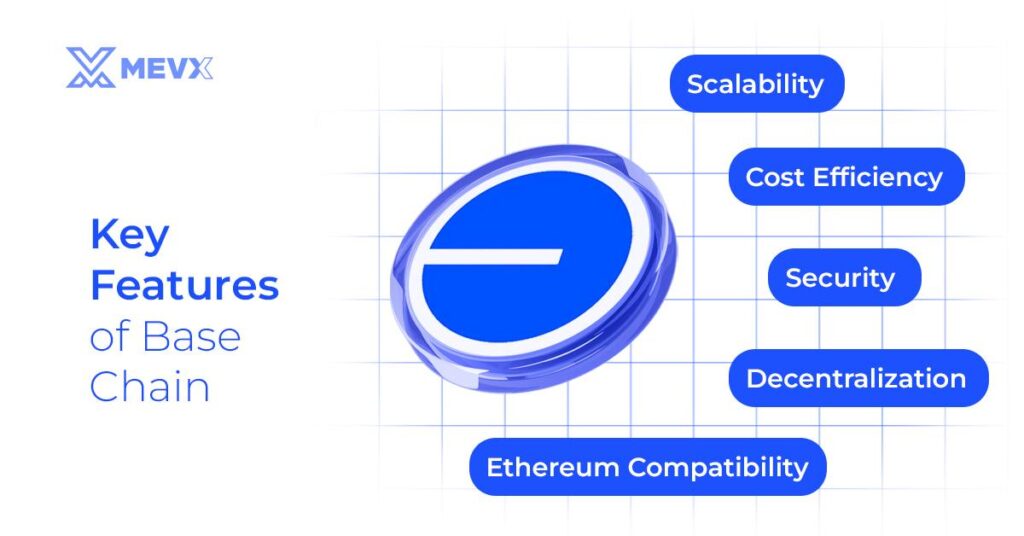Base Chain is a layer-2 network developed by Coinbase on top of Ethereum. It was designed to fix scalability, efficiency, and high transaction cost issues. How does Base Chain work? While Base Chain works as an extension of the Ethereum mainnet in a seamless way, it uses state-of-the-art technologies such as rollups and the OP Stack for performance optimization.
This article will discuss the technical details of Base Chain, explaining its core architecture, consensus mechanisms, and features.

Core Architecture of Base Chain
Base Chain is built on a modular and scalable architecture based on Optimism’s OP Stack. Its core components include the following:
- Layer-2 Architecture
Base Chain is a Layer-2 scaling solution, sitting on top of Ethereum’s Layer-1 blockchain. The principle behind this is to separate the execution layer from the final settlement layer to make it much faster and cheaper. Ethereum’s Layer-1 (L1) forms the foundation layer that keeps the blockchain secure and decentralized. - Rollups: The Backbone of Base Chain
Rollups are the main mechanism that enables Base Chain to achieve scalability. They work by bundling multiple off-chain transactions into a single batch, which is then submitted to Ethereum’s L1 for validation. This reduces the number of on-chain interactions, easing congestion and lowering gas fees. Base Chain specifically employs Optimistic Rollups as its rollups solution. - The OP Stack
The OP Stack is a modular framework developed by Optimism to create scalable and interoperable L2 networks. Base uses this framework to:
Optimize Transactions: Process transactions off-chain while maintaining Ethereum’s L1 security.
Enable Customization: Allow developers to modify and extend the L2 protocol to suit their needs.
Ensure Interoperability: Maintain seamless compatibility with Ethereum’s ecosystem, including its dApps and smart contracts.
How Does Base Chain Work in Processing Transactions?
Base Chain has its transaction processing combined with both off-chain and on-chain for scalability without compromising on security. How it works is as explained below:
Off-Chain Processing
Any transaction initiated by a user on Base gets first processed off-chain, which is much faster and cost-effective. With the help of the rollup mechanism, these transactions get batched into bundles.
Batch Submission to Ethereum
These batched transactions will be settled on Ethereum’s L1 periodically. Each batch will have a cryptographic proof (or state root) that represents the new state of the chain. In this way, all transactions are guaranteed integrity without requiring individual validation on the mainnet.
Optimistic Assumptions
Base Chain’s Optimistic Rollups work on the principle that all transactions are honest until invalidated. This is where the validators have a period to challenge suspicious transactions. In such cases, if a fraudulent transaction is found, the rollup mechanism automatically reverses the transaction to ensure security.
Consensus Mechanisms in Base Chain
While Base Chain draws its security from Ethereum’s PoS consensus mechanism, its L2 operations depend on different mechanisms:
- Optimistic Rollups
Optimistic Rollups are central to Base Chain’s consensus process. They assume transactions are valid and rely on validators to monitor for fraud. Key features include:
Fraud Proofs: Validators can submit fraud proofs if they detect discrepancies in a batch.
Economic Incentives: Validators are incentivized to act honestly through penalties and rewards, discouraging malicious behavior. - Ethereum’s Role
Since Base commits its rollup batches to Ethereum, it inherits security from Ethereum’s PoS validators. These also validate that the L2 batches follow the rules of the mainnet, adding to the security.
Key Features of Base Chain
The architecture and mechanisms that Base applies unlock a lot when it comes to increasing its usability and performance. Here are some of the most important ones:

- Scalability
Base Chain’s main contribution to scalability involves the capability of processing transactions off-chain and collecting them in rollups, hence on-chain congestion on Ethereum’s mainnet is reduced. Such scalability caters to high-throughput applications, from DeFi to NFT marketplaces. - Cost Efficiency
The minimum on-chain interactions reduce gas fees considerably. In this respect, the chain is more affordable for both developers and users, which contributes to widespread adoption. - Ethereum Compatibility
Full interoperability with Ethereum by Base ensures seamless integrations with existing dApps, smart contracts, and tools such as Solidity and Web3.js. The migration of their Ethereum projects to Base requires much less modification for the developers. - Security
Base inherits the robust security of Ethereum’s L1 via its rollup mechanism. Detection of fraud via challenge windows in conjunction with Ethereum’s PoS validators enhances the security of the network. - Decentralization
By using the decentralized architecture of Ethereum, Base ensures that no single entity can control the network. Its modular framework further allows for more decentralization in the future.
Interaction Between Base Chain and Ethereum
The seamless interaction of Base Chain with Ethereum forms the backbone of the former. How this interaction takes place includes:
- Data Availability: All transactional data processed on Base is recorded on Ethereum, hence guaranteed to be transparent and publicly available. In this way, the state of the L2 network can be verified via the immutable ledger of Ethereum by developers and users.
- Cross-Chain Communication: Base Chain provides for efficient communication between L2 and L1 via smart contracts. These act as bridges for the transfer of assets and information from one layer to another.
- Security Inheritance: By publishing the rollup batches to Ethereum, Base inherits Ethereum’s PoS security, which ensures the integrity of its operations.
Advantages of Base Chain’s Technical Design
The technical design of Base has several advantages over traditional blockchain architectures:
- Improved Throughput: The rollup mechanism increases transaction capacity without compromising security.
- Lower Fees: Off-chain processing and batch submissions reduce gas fees, making blockchain applications more affordable.
- Developer-Friendly Environment: Compatibility with Ethereum tools simplifies development, encouraging innovation.
- High Security: Optimistic Rollups and Ethereum’s PoS offer the entire security of the chain in terms of fraud and attacks.
Challenges and Limitations
Notwithstanding its merits, Base does face some challenges:
- Fraud Detection Delays: The window for the challenge of detecting fraud may lead to slight delays.
- Competition: Other L2 solutions like Arbitrum and Polygon provide similar scalability advantages, intensifying competition.
- Adoption: Establishing trust and driving developer and business adoption remains an ongoing effort.
Conclusion
Base Chain is a leap in the scalability and efficiency of blockchain. Technologies like Optimistic Rollups combined with the OP Stack create a balance of performance and security on a very strong platform on which decentralized applications can be placed. Due to the seamless integration with Ethereum’s mainnet, its developer-friendly design will place Base as one of the majors in this ever-changing blockchain landscape. With growing adoption, technical innovations on Base will drive the future of decentralized applications and blockchain technology.
Explore more about Base Chain with our blog now!
Share on Social Media:
